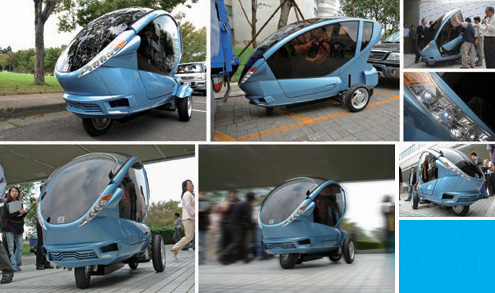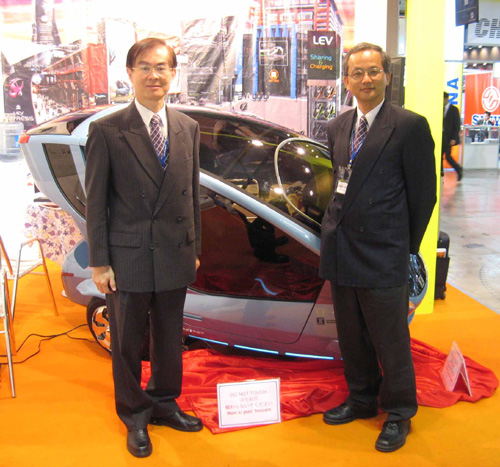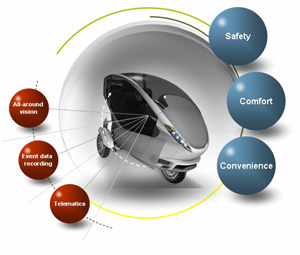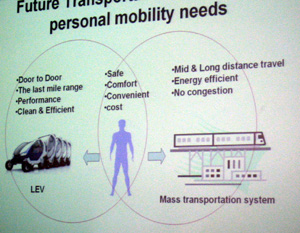ITRI Unveils the Eco-friendly LEV at EICMA 2008
2008/04/09 | By Quincy LiangThe Taiwan-based Mechanical & System Research Laboratories (MSL, formerly MIRL (Mechanical Industry Research Laboratories) under Industrial Technology Research Institute (ITRI) recently premiered a brand-new urban-transportation concept vehicle, the ITRI LEV (Light Electric Vehicle), at the EICMA 2007, the 65th International Bicycle and Motorcycle Exhibition in Milan, Italy, making the R&D achievement one of the most eye-catching exhibits at the major international trade fair.
James Wang, director of the Intelligent Mobility Technology Division of MSL, leading a team of more than 100 talents for vehicle technology R&D in ITRI, pointed out that the LEV is the synthesis of a number of innovative vehicular technologies that have been successfully developed or are being developed by MSL and ITRI. MSL has been the most important R&D citadel in Taiwan for researching vehicular technologies in all fields.

According to Wang, the LEV is a solution developed for personal mobility in the future that bridges the last-gap between a user and mass transportation systems.
"The LEV plays a role stressing door-to-door, last-mile range, performance, and eco-friendliness," the key man in Taiwan's vehicular industry said, "associated with the advantages of mass transportation systems, such as ideal applicability for mid- and long-distance travel, energy efficiency, and minimal congestion. An LEV is a safe, comfy, convenient and cost-efficient personal mobility vehicle."
The energy-efficient, lightweight, and smart LEV features many outstanding characteristics achieved by different advanced sub-systems developed by ITRI, including compact body for maneuverability and parking; active safety and occupant protection (safety and security); electric propulsion system (clean power); and advanced telematics system.
So, the advanced concept LEV also acts like an integrated vehicle platform to integrate and display all the most advanced vehicular technologies developed by different teams of ITRI, Wang added, with such technologies, once transferred to interested firms, being ready for commercialization.
Major Technologies
Basically, there are four key sub-systems on the LEV, Wang said, including the diamond-shaped chassis, safety system for driver assistance, auto tilting for anti-rollover, and the advanced electric power system.
The innovative and patented diamond-shaped chassis has a "four-wheeled" layout, including one steering wheel, two front and one rear wheel. Such chassis design sets the LEV apart from others by offering amazing steering maneuverability-able to virtually rotate on-the-spot with a circumrotation radius of just 1.3 meters.
According to Wang, the diamond-shaped chassis enables rotational steerability that makes maneuvering in tight spaces easier without involving complex chassis design. In other words, the LEV is ideal for personal mobility in congested urban settings.

The chassis design also includes some key albeit less-than-original technologies, including the diamond-configured four-wheel layout and power control; on-the-spot steerability, and rear-wheel steering; and the steering wheel with restriction switching control. Other chassis specifications include a 1,850mm wheel base and 980mm track.
The LEV's safety system for driver assistance reflects considerable R&D strength in vehicular safety, including the all-around vision, event data recording, telematics system, etc. Such electronic features effectively enhance safety-enabling the LEV to be easily driven in urban settings and connected to various services.
Also the LEV features several advanced electronics system developed by MSL, including forward-collision warning, blind-spot warning, image compression and storage, embedded system hardware design, all-around monitoring, etc.
The vehicle's all-around vision is enabled by a charge coupling device (CCD) and complementary metal-oxide-semiconductor (CMOS) cameras (with viewable range of 0-4 meters) around the vehicle, which can display on the dashboard images of the front, side, and rear of the vehicle, with such pan-viewing system also connectable to active safety systems such as the lane departure warning system (LDWS) and front collision warning system (FCWS).

The telematics of the LEV, basically, is the same version ITRI developed for a car, including GPS navigation, GPRS/3G mobile telecom, on-board diagnostic, CAN communication interface, multimedia entertainment, etc. The versatile and integrated telematics on the LEV shows significant R&D capability of the local vehicular-electronics industry.
Another key technology on the vehicle is the auto-tilting system to minimize rollovers, whereby the patented system enables all-wheel tilting to shift the center-of-gravity around corners to achieve excellent anti-rollover capability, especially relevant with LEV's narrow track. Such feature, coupled with the small footprint of the vehicle, provides the LEV with a practical level of maneuverability and hence safety. The auto-tilting system has two modes-enabled or disabled, with the former starting to function at 15 kilometer per hour (kph) with a anti-rollover capability of 0.7G.

In addition, the auto-stand-lock control technology is developed for low-speed driving or stand stop.
The electric power system for the LEV includes high-efficiency hub motors with steering motion control and an advanced Li-ion battery pack, hence helping to achieve compact design, zero-emissions, and energy-efficiency.
The motor control technology features brush-less DC motors with metal oxide semiconductor field-effect transistor (MOSFET) and drivers which deliver very energy-efficient power output; the control unit also manages voltage regulation and brake regeneration, which recycles the power generated by braking.
The power system is also to be designed with swappable pack of quick-rechargeable Li-ion cells.
The hub motors on the LEV come in two optional sizes-10 and 12 inches. Each motor can generate a maximum torque of 75 Nm and maximum power of 3kW (48V DC). The battery and management system can be developed into a system with the features below:
1. Maximum 400V.
2. Four-cell packs in parallel for 4.3 kWh.
3. Quick recharge in 15 min. to regain 50% capacity.
4. Measurement functions accurate to +/- 10mV in cell voltage and +/- 2-dgree C in cell temperature.
A Global Trend
MSL general director Wu Tung-Chuan said that the development of intelligent vehicles has become a global trend. Most research is being targeted at power transmission, chassis, safety, security and telematics, with Taiwan companies boasting particular strengths in the latter three.
Dr. Wu added that the MSL has developed many highly successful technologies over the years to hasten innovation and development of Taiwan's vehicle industry. One example is the LDWS safety system that detects abnormal lane changes to automatically warn drivers, a system integrated on the LEV. MSL has also made advances in gasoline-electric hybrid systems. "The LEV is one of the most innovative vehicle concepts that ITRI has developed to this point," Wu claimed. "A number of local auto and parts makers have expressed an interest in the technologies used in the prototype, adding that it is just a matter of time before this leads to a new lifestyle and an innovative automotive industry."
"Countries throughout the world are urgently developing intelligent vehicles and robots to make life more convenient amid a rapidly aging societies and over-urbanization," Wang pointed out. "ITRI's latest 'intelligent personal mobility' vehicular concepts and service models have turned over a fresh page in future vehicles and set up potential business opportunities in the automotive and mass transportation sectors."
Wang said that the ITRI welcomes international vehicle makers to team up to work on commercialization of futuristic vehicles or any of the key technologies adopted on its prototypes.




